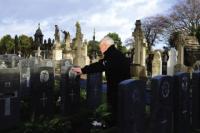Armistice Day e-book
Published in 20th-century / Contemporary History, Issue 6 (Nov/Dec 2012), News, Volume 20, World War I
A participant touches one of the 43 headstones of Irish servicemen and women from both world wars dedicated at an ecumenical ceremony held in Glasnevin Cemetery on 11 November 2010—one of the final set of images in David O’Flynn’s e-book.
There is much talk these days of a ‘decade of centenaries’, but this renewed emphasis on impending commemoration shouldn’t obscure those commemorations that are already established. At this time of year one looms large: Armistice Day, 11 November. To mark it, the Dublin photographer David O’Flynn has compiled a collection of his photographs, available to download free of charge as an e-book.
Ireland went to war in August 1914 with the rest of the United Kingdom, and over the next four years approximately 210,000 Irish men served in the British armed services. Perhaps as many as 35,000 were killed. All were volunteers, as Ireland was the only part of the UK not to be subject to conscription. But, having successfully broken away from the UK in the 1920s, the Irish state may well have been the only one in western Europe that seemed consciously to forget the involvement of its people in the war. No doubt there was a degree of official amnesia, as the struggle for independence from Britain was inevitably going to be a more obvious point of reference for the new state, and the awkward reality of Irish service in British colours was perhaps too inconvenient to digest, regardless of the motives that compelled Irishmen to enlist. But such dismissive attitudes were not confined to the southern state. In the equally new entity of Northern Ireland, unionists sought to claim Irish war service as an exclusively Protestant phenomenon, and discreetly airbrushed those Irish troops with Catholic and nationalist backgrounds from the official record. The wartime sacrifice was naturally of great significance to the Protestant tradition and played a significant role in public life in the North, but the full extent of Ireland’s involvement in the war was obscured on both sides of the new border.

David O’Flynn’s e-book
The First World War is the essential backdrop to the struggle for independence, though the average Irish citizen is far more likely to have had an ancestor in the British army than in the GPO. In recent years the reality of that Irish involvement in the war has come to be much more widely recognised, and certainly seems to have struck a chord with the Irish public. David O’Flynn’s In remembrance is an elegant and fascinating portfolio of images, with accompanying text, that addresses the commoration of the Great War in Ireland in the first decade of the 21st century. Both the images and the text focus on four discrete themes.
The themes relate to the graves of nine soldiers—four Irish, two Scottish, two English and possibly one Welsh—who all died on 11 November 1918 and who are all buried in the Republic of Ireland. The reasons for their deaths remain obscure but the timing makes it unlikely that they were victims of the independence struggle: some may have died from their injuries after having been repatriated from the front, or they may have fallen victim to Spanish Flu. Their graves are depicted in the first set of images. The next two sets of images are intertwined and focus on the differing ways in which the war was remembered, North and South. The rather muted commemoration at the long-neglected memorial gardens at Islandbridge in 2008 is contrasted with the more official celebrations at Enniskillen in 2009. The laying of wreaths by local schoolchildren is the only obvious thing that the two had in common, though it is impossible, when looking at the images of Enniskillen, not to think of the bombing of the Remembrance Sunday ceremony by the IRA in 1987, with the deaths of eleven people.
The final theme is, perhaps appropriately, one of tentative reconciliation. The Commonwealth War Graves Commission (CWGC) lists 2,602 casualties from the First World War who are buried in the Republic. In 2009 the CWGC and the Glasnevin Trust embarked on a project to mark the graves of those Irish servicemen (and servicewomen) killed in both world wars who were buried in unmarked graves in Glasnevin. The final set of images is of the ecumenical ceremony held in Glasnevin on 11 November 2010, as the headstones for 43 of the 205 relevant graves identified were officially dedicated. Given the traditional associations of Glasnevin Cemetery with Irish nationalism, the symbolism of this should be obvious, as a testimony to the complexities that will hopefully be teased out in our own ‘decade of centenaries’. HI
In remembrance can be downloaded free of charge at www.clix.ie.
















